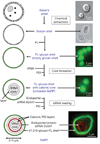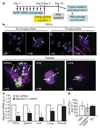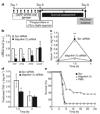Orally delivered siRNA targeting macrophage Map4k4 suppresses systemic inflammation
- PMID: 19407801
- PMCID: PMC2879154
- DOI: 10.1038/nature07774
Orally delivered siRNA targeting macrophage Map4k4 suppresses systemic inflammation
Abstract
Gene silencing by double-stranded RNA, denoted RNA interference, represents a new paradigm for rational drug design. However, the transformative therapeutic potential of short interfering RNA (siRNA) has been stymied by a key obstacle-safe delivery to specified target cells in vivo. Macrophages are particularly attractive targets for RNA interference therapy because they promote pathogenic inflammatory responses in diseases such as rheumatoid arthritis, atherosclerosis, inflammatory bowel disease and diabetes. Here we report the engineering of beta1,3-D-glucan-encapsulated siRNA particles (GeRPs) as efficient oral delivery vehicles that potently silence genes in mouse macrophages in vitro and in vivo. Oral gavage of mice with GeRPs containing as little as 20 microg kg(-1) siRNA directed against tumour necrosis factor alpha (Tnf-alpha) depleted its messenger RNA in macrophages recovered from the peritoneum, spleen, liver and lung, and lowered serum Tnf-alpha levels. Screening with GeRPs for inflammation genes revealed that the mitogen-activated protein kinase kinase kinase kinase 4 (Map4k4) is a previously unknown mediator of cytokine expression. Importantly, silencing Map4k4 in macrophages in vivo protected mice from lipopolysaccharide-induced lethality by inhibiting Tnf-alpha and interleukin-1beta production. This technology defines a new strategy for oral delivery of siRNA to attenuate inflammatory responses in human disease.
Figures





References
-
- Fire A, et al. Potent and specific genetic interference by double-stranded RNA in Caenorhabditis elegans. Nature. 1998;391:806–811. - PubMed
-
- Duffield JS. The inflammatory macrophage: a story of Jekyll and Hyde. Clin. Sci. (Lond.) 2003;104:27–38. - PubMed
-
- Beier R, Gebert A. Kinetics of particle uptake in the domes of Peyer’s patches. Am. J. Physiol. 1998;275:G130–G137. - PubMed
-
- Herre J, Gordon S, Brown GD. Dectin-1 and its role in the recognition of β-glucans by macrophages. Mol. Immunol. 2004;40:869–876. - PubMed
Publication types
MeSH terms
Substances
Grants and funding
LinkOut - more resources
Full Text Sources
Other Literature Sources
Molecular Biology Databases
Miscellaneous

